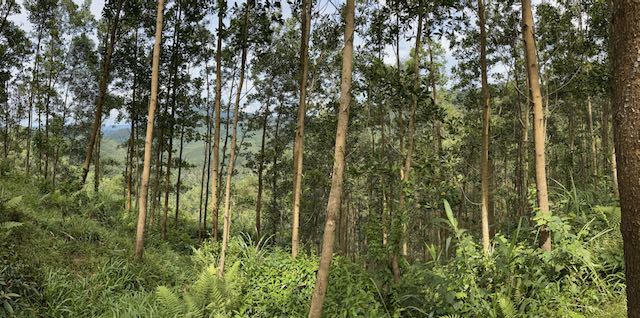Colleagues from the FT Viet project have now published their top-notch research based on a set of rigorous in-depth surveys of tree farmers in Thừa Thiên-Huế province, central Vietnam. About a fifth of this province is now covered with tree plantations, mostly comprising the Australasian fast-growing tree Acacia magnum and Acacia magnum x Acacia auriculiformis hybrids. They interviewed 180 farmers across districts in the coastal plains, midland hills, and uplands, with half involved in Forest Stewardship Council groups that produce timber sawlogs under FSC certification standards, and half not involved (these tended to produce wood chips instead). The two published articles are an extremely rich and well-described source for understanding the development of acacia plantations over time, their relation to farmer assets and livelihoods, changes in land management, and farmer’s views on environmental challenges and future opportunities.

The research shows that on the one hand, the plantations contribute to growth in the wood products industry and associated labor, but on the other hand, in just a few decades they have displaced other more diverse land uses. While land and forest allocation in Vietnam has benefitted quite a broad swath of society (i.e., most village households, most respondents in the survey), some social differentiation is noted, in that (for instance) the farmers who most dramatically benefitted from the plantations (and also participate the FSC program and its more environmentally-friendly practices) tended to already be wealthier.
Farmers observed a decline in faunal biodiversity in their acacia plantations as opposed to previous land uses such as grass- or bushland or secondary forest. Furthermore, economic activity, while gaining more income, is narrowed down from previously diverse livelihoods. Acacia plantations have little room for livestock keeping, NTFP collection, or hunting of wildlife (honey production is one exception). For other ecosystem services, like climate regulation and amenities, farmer’s perceptions tended to be somewhat positive. For the future, farmers identified a number of risks, including extreme weather causing tree falls and plant diseases. Timber certification schemes such as FSC, if accessible to all farmers, could help build resilience and sustainability by allowing farmers to access higher-price markets, and fostering more environmentally friendly and socially considerate standards of planation management.
For all of the details, don’t trust my summary, please carefully read the papers below. They include quite some rich information on
- the historical, policy, and geographic context
- how people got into acacia planting (when, which project, what incentives and support, why)
- land cover and land ownership in acacia plantations
- farmer assets, income, and livelihoods before and after acacia plantations
- techniques for planting, rotation, intercropping, labour, and stand management
- size of plantations, distance from villages, harvesting time
- native vegetation in or near acacia plantations
- farmer perceptions on infrastructure and capital
- farmer perceptions on environment, risk, and the future
- engagement, outlooks, and knowledge with respect to FSC timber certification
Here are the references to the paper (with open access PDFs):
